As a loving pet owner, the safety of your furry companions is always a top priority, especially when it comes to the lush greenery adorning your home. One plant that frequently sparks concern and questions is the beloved prayer plant, known for its vibrant foliage and mesmerizing “praying” leaf movements. Are these beautiful botanicals truly safe, or are all prayer plants pet safe an urban myth?
This comprehensive guide will cut through the confusion, providing you with definitive answers backed by expert insights. We’ll explore the entire prayer plant family, clarify what “non-toxic” truly means for your cats and dogs, and most critically, equip you with the knowledge and visual cues to differentiate genuinely safe prayer plants from dangerously toxic lookalikes. By the end, you’ll have the ultimate peace of mind to enjoy your plants and pets harmoniously.
TABLE OF CONTENTS
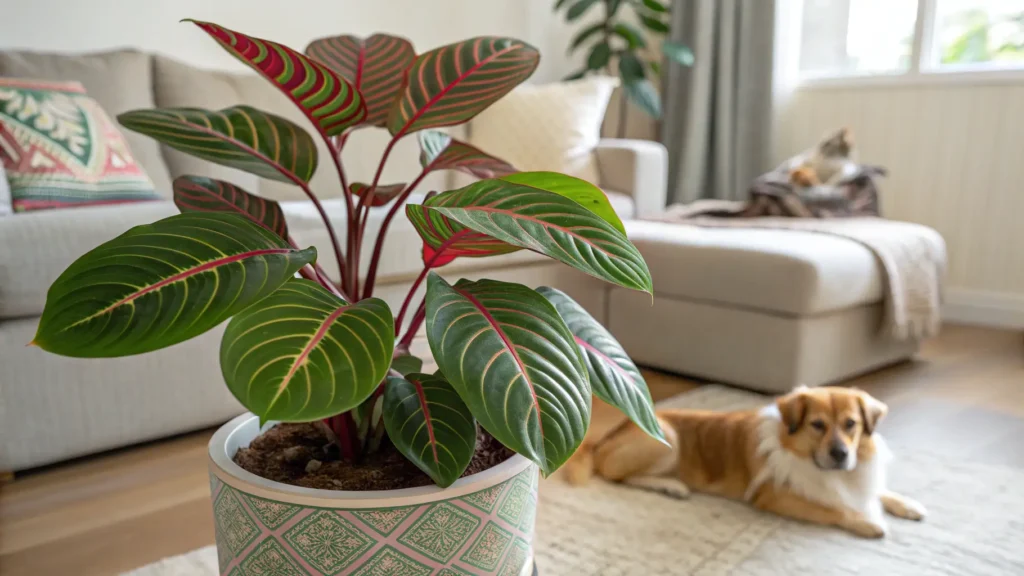
The Short Answer: Are All Prayer Plants Pet Safe for Cats and Dogs?
Let’s get straight to the point: Yes, prayer plants are generally considered non-toxic to cats and dogs. This is a huge relief for many pet parents! The most common genera referred to as “prayer plants” – Maranta, Calathea, Stromanthe, and Ctenanthe, all belonging to the Marantaceae family – do not contain compounds known to cause severe poisoning or systemic illness in pets.
While ingestion typically won’t lead to serious health issues, it’s important to understand that “non-toxic” doesn’t necessarily mean “zero reaction.” Your pet might still experience mild, temporary symptoms if they nibble on the leaves or stems.
Key Takeaway Box: Prayer Plant Pet Safety
- Verdict: Generally NON-TOXIC for cats and dogs.
- Family: Most “prayer plants” belong to the Marantaceae family (Maranta, Calathea, Stromanthe, Ctenanthe).
- Potential Symptoms: Mild, temporary gastrointestinal upset (e.g., vomiting, drooling, diarrhea).
- Action: Monitor your pet closely. For severe or persistent symptoms, consult your veterinarian.
- Next Steps: Jump to: What to Do If Your Pet Eats a Prayer Plant (Step-by-Step Guidance)
Understanding “Non-Toxic”: What Does It Truly Mean for Your Pet?
The term “non-toxic” in the context of pet safety can sometimes be a source of confusion. It doesn’t mean your pet can safely consume an entire plant without any consequences. Instead, it signifies that the plant does not contain compounds that cause severe organ damage, systemic illness, or life-threatening reactions when ingested in typical amounts.
For prayer plants, while they are not poisonous, a pet might still experience mild gastrointestinal upset. This is often due to the fibrous plant material itself or minor irritants that can cause a temporary reaction in a sensitive stomach.
What to Expect (and Not Expect):
- Expected (Mild Symptoms):
- Vomiting: Your pet might vomit a few times shortly after ingestion.
- Diarrhea: Loose stools, typically resolving within 24-48 hours.
- Drooling: Excessive salivation, indicating mouth irritation.
- Mild Lethargy: A temporary dip in energy while their stomach settles.
- NOT Expected (Serious Symptoms – Contact Vet Immediately if Seen):
- Severe, persistent vomiting or diarrhea
- Respiratory distress or difficulty breathing
- Seizures or tremors
- Collapse or extreme weakness
- Significant changes in behavior or consciousness
These mild symptoms are usually temporary and self-resolving, often not requiring veterinary intervention unless they become persistent or severe. Think of it like a human eating too much fibrous greens – it might cause a minor stomachache, but it’s not poisoning. The American Society for the Prevention of Cruelty to Animals (ASPCA) consistently lists Marantaceae family plants as non-toxic to pets.
FOR MORE INFORMATION : Poisonous Plants
The “Prayer Plant Family”: Maranta, Calathea, Stromanthe & Ctenanthe Genera Explained
When people refer to “prayer plants,” they’re often talking about a diverse group of plants within the Marantaceae family, all sharing a captivating characteristic: their leaves fold upwards at night, resembling hands in prayer, and then unfurl with the morning light. Rest assured, all known species within these commonly recognized genera are considered non-toxic to your beloved pets.
Here’s a closer look at the key genera that fall under the “prayer plant” umbrella and are safe for your home:
- Maranta (e.g., Red Vein Prayer Plant, Lemon Lime Prayer Plant): Perhaps the most iconic, known for its intricate leaf patterns and contrasting colors.
- Calathea (e.g., Rattlesnake Plant, Peacock Plant, Pin-Stripe Calathea): A vast and popular genus with incredibly diverse and often strikingly patterned foliage. Many Calatheas have vibrant undersides.
- Stromanthe (e.g., Triostar Stromanthe): Similar to Calatheas but often with more elongated leaves and brilliant pink, cream, and green variegation.
- Ctenanthe (e.g., Grey Star Ctenanthe, Burle Marxii): Another genus with beautiful, patterned leaves, often with a slightly more upright growth habit.
Understanding this family is crucial because it ensures that when you choose a plant labeled as a “Calathea” or “Stromanthe,” you can be confident in its non-toxic status.
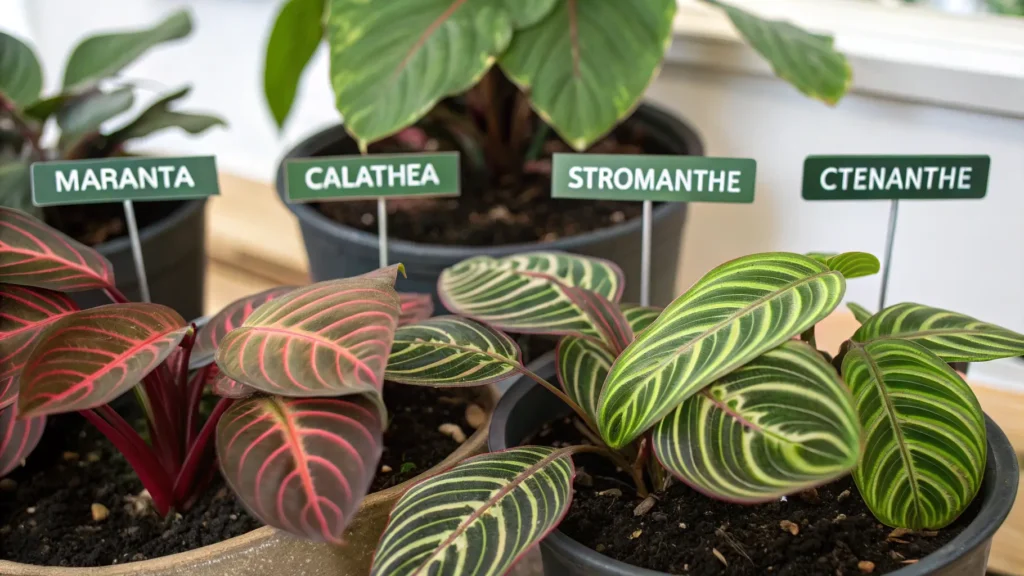
Crucial: Toxic Plants That Look Like Prayer Plants (Avoid These!)
This is where the most significant confusion – and danger – lies for pet owners. Many truly toxic houseplants are often mistaken for prayer plants due to similarities in leaf shape, variegation, or growth habit. Misidentification can have serious consequences. This section is your essential guide to confidently distinguishing between pet-safe prayer plants and dangerous imposters.
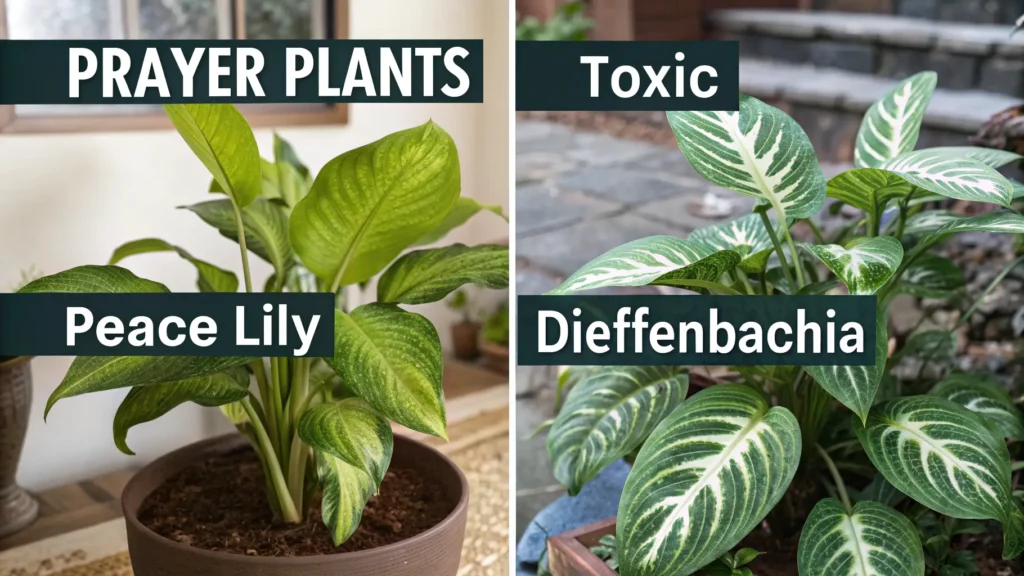
Here are some of the most commonly confused toxic plants you should absolutely avoid having within reach of your pets:
Peace Lily vs. Prayer Plant: Key Visual Differences
The Peace Lily (Spathiphyllum) is a common culprit for confusion. While both have lush green leaves, their flowers are distinct, and the Peace Lily is toxic.
- Peace Lily (Toxic): Contains calcium oxalate crystals. Ingestion causes immediate oral irritation, intense burning of the mouth, drooling, vomiting, and difficulty swallowing.
- Prayer Plant (Non-Toxic): Does not contain these irritating crystals.
How to Spot the Difference:
- Flowers: The most obvious differentiator. Peace Lilies produce a distinct white or off-white “spathe” (leaf-like bract) surrounding a central “spadix” (flower spike). Prayer plant flowers are typically small, inconspicuous, and often purple or white, growing on short spikes, not surrounded by a large bract.
- Leaf Texture: Peace Lily leaves are often smoother and glossier. Prayer plant leaves tend to have a slightly more matte finish, often with prominent veins and distinct patterns.
- Growth Habit: Peace Lilies often grow in a more upright, clumping manner. Many prayer plants, especially Marantas, have a spreading or trailing habit.
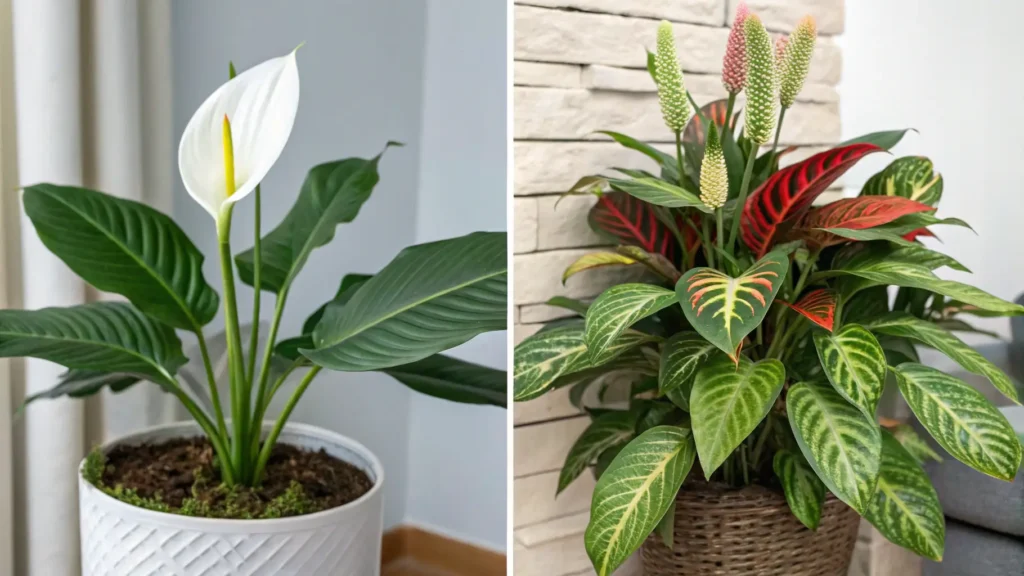
Dieffenbachia vs. Prayer Plant: Spotting the Impostor
Dieffenbachia, often called “Dumb Cane,” is another highly toxic plant that can be confused with prayer plants due to its large, patterned leaves. Like Peace Lilies, it contains calcium oxalate crystals.
- Dieffenbachia (Highly Toxic): Causes severe oral irritation, swelling of the mouth and throat, intense pain, drooling, vomiting, and difficulty speaking or swallowing. Can lead to airway obstruction in severe cases.
- Prayer Plant (Non-Toxic): Safe for pets.
How to Spot the Difference:
- Leaf Size and Thickness: Dieffenbachia leaves are typically much larger, thicker, and often more elongated than most prayer plant leaves.
- Stem Structure: Dieffenbachia has a thick, often fleshy stem. Prayer plants have more slender, often fibrous stems.
- Overall Stature: Dieffenbachias grow into much larger, more robust plants, often resembling small shrubs. Prayer plants generally remain smaller, with a more delicate or spreading habit.
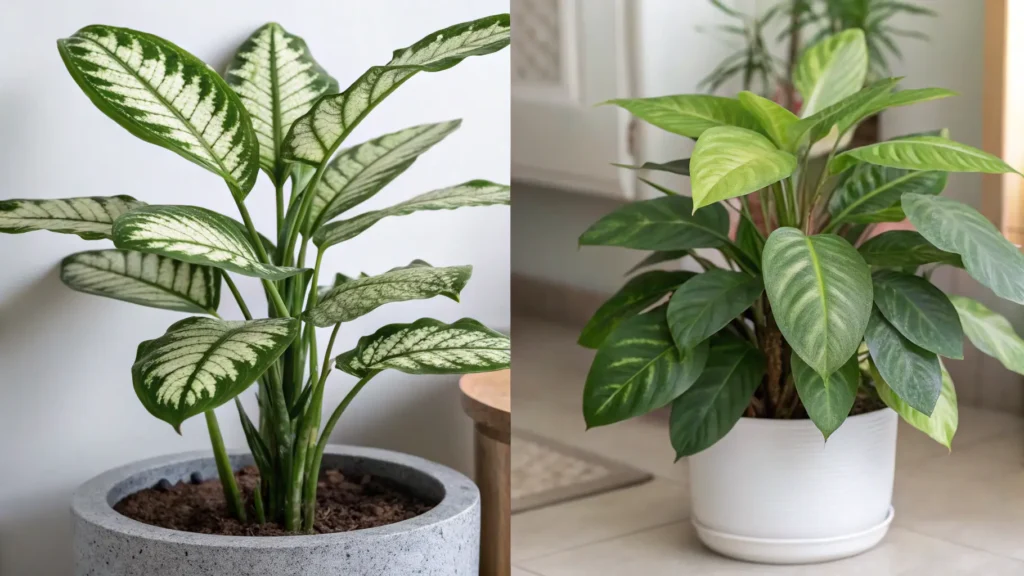
Other Toxic Plants Often Confused with Prayer Plants:
- Chinese Evergreen (*Aglaonema*): Also contains calcium oxalate crystals and can cause similar oral irritation to Dieffenbachia and Peace Lily. Often has patterned leaves, but typically thicker stems and a different growth habit.
- Pothos (*Epipremnum aureum*): A very common houseplant with trailing vines and heart-shaped leaves, often variegated. While it doesn’t fold its leaves, young Pothos can sometimes be mistaken for the more vibrant prayer plants. Pothos also contains calcium oxalates.
Always double-check the scientific name of any new plant you bring home and cross-reference it with reliable pet toxicity lists.
What to Do If Your Pet Eats a Prayer Plant (Step-by-Step Guidance)
Even though prayer plants are non-toxic, it’s natural to feel concerned if you catch your pet munching on one. Here’s a clear, step-by-step guide on how to respond.
1. Don’t Panic: Remember, prayer plants are non-toxic. The immediate threat of severe poisoning is extremely low. Your calm demeanor will also help keep your pet calm.
2. Observe Your Pet: Watch for any mild symptoms like increased drooling, lip licking, a single episode of vomiting, or mild diarrhea. These usually appear within a few hours of ingestion.
3. Remove the Plant Material: Gently remove any remaining plant material from your pet’s mouth or fur.
4. Offer Fresh Water: Encourage your pet to drink fresh water to help rinse any potential irritants and keep them hydrated, especially if they are vomiting.
5. When to Contact Your Veterinarian:
* Persistent or Severe Symptoms: If your pet experiences repeated vomiting, severe diarrhea, lethargy, loss of appetite, or any signs of discomfort that last longer than a day.
* Pre-existing Conditions: If your pet has a history of gastrointestinal issues, allergies, or any chronic health conditions.
* Large Quantity Ingested: If your pet has consumed a significant amount of the plant, which could lead to a more pronounced physical reaction, even if not toxic.
* Uncertainty: When in doubt, it’s always best to call your vet or the Pet Poison Helpline for professional advice.
6. Prepare for a Vet Call: Have the following information ready:
* The exact name of the plant (e.g., Maranta leuconeura ‘Red Vein’)
* The estimated amount ingested
* Any symptoms your pet is showing (and their severity/duration)
* Your pet’s species, breed, age, weight, and any pre-existing health conditions or medications.
Beyond Toxicity: Comprehensive Pet-Proofing Your Houseplants
Even with non-toxic plants like prayer plants, it’s wise to implement pet-proofing strategies. This not only prevents mild stomach upsets but also discourages pets from developing a habit of chewing on any plant, potentially leading to ingestion of truly toxic varieties down the line. A proactive approach to houseplant safety for pets is key to a harmonious home.
Smart Plant Placement & Physical Barriers
The simplest and often most effective method is to make plants inaccessible.
- High Shelves & Bookcases: Place plants well out of paw and reach.
- Hanging Planters: Utilize macrame hangers or ceiling hooks to suspend plants safely overhead.
- Tall Plant Stands: Elevate plants on sturdy, heavy stands that pets can’t easily knock over.
- Terrariums or Enclosures: For smaller plants, consider decorative terrariums or cloches that act as beautiful barriers.
- Pet Gates: Use baby gates to restrict access to rooms where plants are kept, especially if you have an adventurous pet.
- Closed Doors: Simply keep doors to plant-filled rooms closed when you’re not supervising.
Deterrents, Distractions, and Training
Sometimes, physical barriers aren’t enough, or your pet is particularly persistent. Behavioral strategies can help.
- Bitter Sprays: Products like bitter apple spray can be applied to leaves (after testing a small area for plant sensitivity). The unpleasant taste often deters chewing. Reapply regularly.
- Tactile Deterrents: Some pets dislike the feel of certain textures. Placing aluminum foil or prickly pinecones around the base of plants can discourage curious paws.
- Provide Alternatives: Ensure your pet has plenty of appropriate chew toys and enrichment. Sometimes, they chew plants out of boredom or a need for mental stimulation. Offer cat grass or other safe chew options.
- Positive Reinforcement Training:
- Redirect: If you catch your pet sniffing or nibbling a plant, gently redirect them to an appropriate toy.
- “Leave It” Command: Train your dog with a “leave it” command for plants and other household items.
- Supervision: Closely supervise young pets or new additions to your home until you understand their behavior around plants.
Expert Tip: “Consistency is key when training pets. Rewarding desired behavior with treats and praise is far more effective than punishment when trying to keep them away from houseplants,” advises a certified animal behaviorist (general advice based on industry research).
Quick Reference: Common Pet-Safe & Toxic Houseplants

Frequently Asked Questions About Prayer Plants & Pet Safety
Here are some common questions pet owners have about prayer plants and their safety.
Is it okay if my cat nibbled a prayer plant leaf?
Generally, yes, it’s okay. Since prayer plants are non-toxic, a small nibble is unlikely to cause serious harm. You might observe mild, temporary symptoms like drooling or a single episode of vomiting. Monitor your cat for a few hours.
What are the specific symptoms of mild irritation if my pet eats a prayer plant?
Mild irritation typically manifests as increased drooling, lip licking, a soft cough, vomiting (usually once or twice), or mild, temporary diarrhea. These symptoms should resolve on their own within 12-24 hours.
Can prayer plants cause allergies in pets?
While rare, any plant material can potentially trigger an allergic reaction in a highly sensitive pet, just like humans can be allergic to specific plants. Symptoms of a plant allergy would be similar to other allergies: skin irritation, itching, redness, or more severe respiratory issues. If you suspect an allergy, consult your vet.
Are all plants in the Marantaceae family safe for pets?
Based on current data from reputable sources like the ASPCA, all common genera within the Marantaceae family that are typically referred to as “prayer plants” (Maranta, Calathea, Stromanthe, Ctenanthe) are considered non-toxic to cats and dogs.
How can I confirm if other plants are safe for my pet?
Always identify a plant by its scientific name. Then, consult trusted resources like the ASPCA’s toxic and non-toxic plant list, the Pet Poison Helpline website, or your veterinarian. When buying new plants, ask for the scientific name to ensure accurate identification.
Conclusion: Enjoy Your Prayer Plants with Peace of Mind (and a Safe Pet!)
Bringing the vibrant beauty of prayer plants into your home doesn’t have to be a source of anxiety for pet owners. By understanding that all prayer plants are pet safe – specifically, the Maranta, Calathea, Stromanthe, and Ctenanthe genera – you can enjoy their stunning foliage and fascinating leaf movements without fear of severe toxicity. We’ve clarified the meaning of “non-toxic,” equipped you with crucial visual cues to avoid dangerous lookalikes, and provided actionable steps for pet-proofing and emergency guidance.
Your home can be a lush, green sanctuary that’s equally safe for your beloved cats and dogs. Armed with this definitive guide, you can confidently grow these magnificent plants, knowing you’ve taken every step to ensure the well-being of your furry family members. Continue to prioritize informed plant choices and proactive pet-proofing, and your prayer plants and pets will thrive together in harmony. If ever in doubt about any specific plant, always consult your veterinarian.
